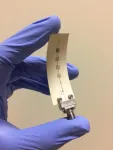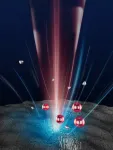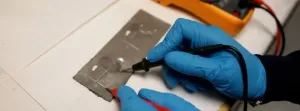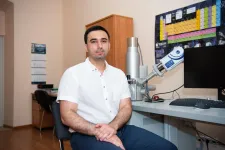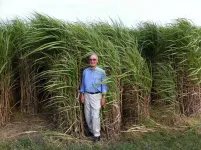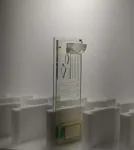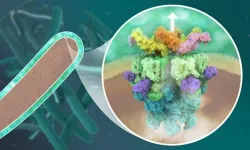(Press-News.org) The promise of 5G Internet of Things (IoT) networks requires more scalable and robust communication systems -- ones that deliver drastically higher data rates and lower power consumption per device.
Backscatter radios ? passive sensors that reflect rather than radiate energy ? are known for their low-cost, low-complexity, and battery-free operation, making them a potential key enabler of this future although they typically feature low data rates and their performance strongly depends on the surrounding environment.
Researchers at the Georgia Institute of Technology, Nokia Bell Labs, and Heriot-Watt University have found a low-cost way for backscatter radios to support high-throughput communication and 5G-speed Gb/sec data transfer using only a single transistor when previously it required expensive and multiple stacked transistors.
Employing a unique modulation approach in the 5G 24/28 Gigahertz (GHz) bandwidth, the researchers have shown that these passive devices can transfer data safely and robustly from virtually any environment. The findings were reported earlier this month in the journal Nature Electronics.
Traditionally, mmWave communications, called the extremely high frequency band, is considered "the last mile" for broadband, with directive point-to-point and point-to-multipoint wireless links. This spectrum band offers many advantages, including wide available GHz bandwidth, which enables very large communication rates, and the ability to implement electrically large antenna arrays, enabling on-demand beamforming capabilities. However, such mmWave systems depend on high-cost components and systems.
The Struggle for Simplicity Versus Cost
"Typically, it was simplicity against cost. You could either do very simple things with one transistor or you need multiple transistors for more complex features, which made these systems very expensive," said Emmanouil (Manos) Tentzeris, Ken Byers Professor in Flexible Electronics in Georgia Tech's School of Electrical and Computer Engineering (ECE). "Now we've enhanced the complexity, making it very powerful but very low cost, so we're getting the best of both worlds."
"Our breakthrough is being able to communicate over 5G/millimeter-wave (mmWave) frequencies without actually having a full mmWave radio transmitter - only a single mmWave transistor is needed along much lower frequency electronics, such as the ones found in cell phones or WiFi devices. Lower operating frequency keeps the electronics' power consumption and silicon cost low," added first author Ioannis (John) Kimionis, a Georgia Tech Ph.D. graduate now a member of technical staff at Nokia Bell Labs. "Our work is scalable for any type of digital modulation and can be applied to any fixed or mobile device."
The researchers are the first to use a backscatter radio for gigabit-data rate mmWave communications, while minimizing the front-end complexity to a single high-frequency transistor. Their breakthrough included the modulation as well as adding more intelligence to the signal that is driving the device.
"We kept the same RF front-end for scaling up the data rate without adding more transistors to our modulator, which makes it a scalable communicator," Kimionis said, adding that their demonstration showed how a single
mmWave transistor can support a wide range of modulation formats.
Powering a Host of 'Smart' IoT Sensors
The technology opens up a host of IoT 5G applications, including energy harvesting, which Georgia Tech researchers recently demonstrated using a specialized Rotman lens that collects 5G electromagnetic energy from all directions.
Tentzeris said additional applications for the backscatter technology could include "rugged" high-speed personal area networks with zero-power wearable/implantable sensors for monitoring oxygen or glucose levels in the blood or cardiac/EEG functions; smart home sensors that monitor temperature, chemicals, gases, and humidity; and smart agricultural applications for detecting frost on crops, analyzing soil nutrients, or even livestock tracking.
The researchers developed an early proof of concept of this backscatter modulation, which won third prize at the 2016 Nokia Bell Labs Prize. At the time, Kimionis was a Georgia Tech ECE doctoral researcher working with Tentzeris in the ATHENA lab, which advances novel technologies for electromagnetic, wireless, RF, millimeter-wave, and sub-terahertz applications.
Key Enabler of Low Cost: Additive Manufacturing
For Kimionis, the backscatter technology breakthrough reflects his goal to "democratize communications."
"Throughout my career I've looked for ways to make all types of communication more cost-efficient and more energy-efficient. Now, because the whole front end of our solution was created at such low complexity, it is compatible with printed electronics. We can literally print a mmWave antenna array that can support a low-power, low-complexity, and low-cost transmitter."
Tentzeris considers affordable printing crucial to making their backscattering technology market viable. Georgia Tech is a pioneer in inkjet printing on virtually every material (paper, plastics, glass, flexible/organic substrates) and was one of the first research institutes to use 3D printing up to millimeter-frequency ranges back in 2002.
INFORMATION:
Other researchers who collaborated on this work included Apostolos Georgiadis and Spyridon Nektarios Daskalakis, both former visiting professors at Georgia Tech now on the faculty of Herriot-Watt University's School of Engineering and Physical Sciences in Edinburgh.
This work was supported by the National Science Foundation-EFRI, the Defense Threat Reduction Agency (DTRA) and by the European Union Horizon 2020 Research and Innovation Programme under the Marie Sk?odowska-Curie grant agreement.
CITATION: J. Kimionis, et al., "A printed millimetre-wave modulator and antenna array for backscatter communications at gigabit data rates." (Nature Electronics, 2021) https://doi.org/10.1038/s41928-021-00588-8.
The Georgia Institute of Technology, or Georgia Tech, is a top 10 public research university developing leaders who advance technology and improve the human condition.
The Institute offers business, computing, design, engineering, liberal arts, and sciences degrees.
Its nearly 40,000 students, representing 50 states and 149 countries, study at the main campus in Atlanta, at campuses in France and China, and through distance and online learning. As a leading technological university, Georgia Tech is an engine of economic development for Georgia, the Southeast, and the nation, conducting more than $1 billion in research annually for government, industry, and society.
Media Relations Contacts: Anne Wainscott-Sargent (404-435-5784) (asargent7@gatech.edu) and Tracey Reeves (treeves@gatech.edu).
Three years ago, Arthur Ashkin won the Nobel Prize for inventing optical tweezers, which use light in the form of a high-powered laser beam to capture and manipulate particles. Despite being created decades ago, optical tweezers still lead to major breakthroughs and are widely used today to study biological systems.
However, optical tweezers do have flaws. The prolonged interaction with the laser beam can alter molecules and particles or damage them with excessive heat.
Researchers at The University of Texas at Austin have created a new version of optical tweezer technology that fixes this problem, a development ...
Want a smartphone that stretches, takes damage, and still doesn't miss a call?
A team of Virginia Tech researchers from the Department of Mechanical Engineering and the Macromolecules Innovation Institute has created a new type of soft electronics, paving the way for devices that are self-healing, reconfigurable, and recyclable. These skin-like circuits are soft and stretchy, sustain numerous damage events under load without losing electrical conductivity, and can be recycled to generate new circuits at the end of a product's life.
Led by Assistant Professor Michael Bartlett, the team recently published its findings in END ...
Scientists from the National University of Science and Technology "MISIS" (NUST MISIS) in cooperation with their colleagues from the Siberian Federal University and the Research and Production Centre of Magnetic Hydrodynamics (Krasnoyarsk) have developed a technology for producing a unique heat-resistant aluminium alloy with improved durability.
According to the researchers, this new alloy could replace more expensive and heavier copper conductors in aircraft and high-speed rail transport. The study results were published in an interdisciplinary, peer-reviewed journal, the Materials Letters. (https://www.sciencedirect.com/science/article/abs/pii/S0167577X2100896X)
Researchers have created a method for producing ...
Night and day, oil tankers, yachts and cargo ships stacked with shipping containers ply the 80-kilometer (50-mile) waterway through the jungles of Panama between the Atlantic and the Pacific Ocean: about 40 ships every 24 hours. But even though the Canal is fed by freshwater rivers that empty through the locks on each end, a system that generally prevents fish and smaller marine invertebrates from hopping from ocean to ocean, some still manage to get through, clinging to the hulls of ships. Other invading species arrive from far-flung ports, dumped with ballast water as ships prepare for transit.
"Panama is a major shipping hub that provides amazing opportunities to test key ideas about marine invasions by studying ...
A team of engineers and clinicians has developed an ultra-thin, inflatable device that can be used to treat the most severe forms of pain without the need for invasive surgery.
The device, developed by researchers at the University of Cambridge, uses a combination of soft robotic fabrication techniques, ultra-thin electronics and microfluidics.
The device is so thin - about the width of a human hair - that it can be rolled up into a tiny cylinder, inserted into a needle, and implanted into the epidural space of the spinal column, the same area ...
A new electrode that could free up 20% more light from organic light-emitting diodes has been developed at the University of Michigan. It could help extend the battery life of smartphones and laptops, or make next-gen televisions and displays much more energy efficient.
The approach prevents light from being trapped in the light-emitting part of an OLED, enabling OLEDs to maintain brightness while using less power. In addition, the electrode is easy to fit into existing processes for making OLED displays and light fixtures.
"With our approach, you can do it all in ...
More corn is grown in the United States than any other crop, but we only use a small part of the plant for food and fuel production; once people have harvested the kernels, the inedible leaves, stalks and cobs are left over. If this plant matter, called corn stover, could be efficiently fermented into ethanol the way corn kernels are, stover could be a large-scale, renewable source of fuel.
"Stover is produced in huge amounts, on the scale of petroleum," said Whitehead Institute Member and Massachusetts Institute of Technology (MIT) biology professor Gerald Fink. "But there are enormous technical challenges to using them cheaply to create biofuels and other important chemicals."
And so, year after year, most of the woody corn material is left in the fields to rot.
Now, a ...
DURHAM, N.C. - Biomedical engineers at Duke University have demonstrated a tablet-sized device that can reliably detect multiple COVID-19 antibodies and biomarkers simultaneously.
Initial results show the test can distinguish between antibodies produced in response to SARS-CoV-2 and four other coronaviruses with 100% accuracy.
The researchers are now working to see if the easy-to-use, energy-independent, point-of-care device can be used to predict the severity of a COVID-19 infection or a person's immunity against variants of the virus.
Having also recently shown the same "D4 assay" platform can detect Ebola infections a day earlier than the gold standard polymerase chain reaction (PCR) test, the researchers say the results show how flexible the technology can be to adapt to other ...
CAMBRIDGE, MA - Boosting production of biofuels such as ethanol could be an important step toward reducing global consumption of fossil fuels. However, ethanol production is limited in large part by its reliance on corn, which isn't grown in large enough quantities to make up a significant portion of U.S. fuel needs.
To try to expand biofuels' potential impact, a team of MIT engineers has now found a way to expand the use of a wider range of nonfood feedstocks to produce such fuels. At the moment, feedstocks such as straw and woody plants are difficult to use for biofuel production because they first need to be broken down to fermentable sugars, a process that releases numerous byproducts that are toxic to yeast, the microbes most commonly used to produce biofuels.
The ...
Tuberculosis is one of the top ten causes of death worldwide, infecting about one-quarter of the world's population. Although it is treatable, the rise of multidrug-resistant tuberculosis poses a major threat to global health security, and has been declared by the World Health Organization as a global health emergency. Reduced access to diagnosis and treatment during the COVID-19 pandemic is expected to dramatically increase the number of tuberculosis infections. This will set global efforts to tackle the disease back several years.
Tuberculosis is caused by infection with Mycobacterium tuberculosis: a bacterium that infects human lungs and other organs by using complex molecular ...
